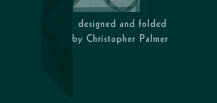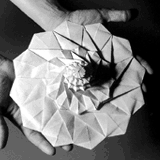|

 fter you've seen a few
Shafer models, you learn to expect the unexpected. There's the Swiss
army knife that opens and closes (and, Shafer promises, really can cut
. . . a cobweb). The flyswatter that turns over to reveal a squashed
man on the other side. The envelope that opens to reveal a pop-up dragon.
fter you've seen a few
Shafer models, you learn to expect the unexpected. There's the Swiss
army knife that opens and closes (and, Shafer promises, really can cut
. . . a cobweb). The flyswatter that turns over to reveal a squashed
man on the other side. The envelope that opens to reveal a pop-up dragon.
One of Shafer's signature
pieces is the "flasher." The flasher hat below folds up instantly
to a cylinder no bigger than a roll of toilet paper. In fact, some of
Shafer's flashers fold up by themselves if you let go of them.
According to Shafer, he
designed the first flasher with Christopher Palmer, after Palmer saw
a rose by a legendary Japanese origamist, Toshikazu Kawasaki. The two
realized they could use Kawasaki's system of pleats to make a model
that could grow or shrink. Shafer estimates that he has designed about
thirty-five different flashers, and he even owes his college degree
to them. As a student at the University of California at Santa Cruz,
he majored in mathematics because "it was the most origami-like
of the majors," and he presented a senior seminar on flashers.
Even his professors were baffled, Shafer recalls. "I taught them
how to fold a flasher," Shafer says. "I was practically having
to fold it for them, because they had the instructions in front of them
but they couldn't follow them. That was quite a turnaround, you know—you
have all those geniuses, and they can't even fold the basic flasher!"
Click
here
for a larger image of Shafer's Flasher Hat.
|
Watch
as Jeremy Shafer displays a large example of a flasher.
See how it expands dramatically, but also shrinks down to
a very compact size
|

|
|

|
|

|
One
of Jeremy Shafer's flashers, transformed into a large and
colorful flasher hat.
|
|
Watch
this clip in RealVideo through the link above, or in the following
formats:
Quicktime
4.0:
985K
or
1.5MB
|
Watch
this clip in RealVideo through the link above, or in the following
formats:
Quicktime
4.0:
522K
or
840K
|
|








